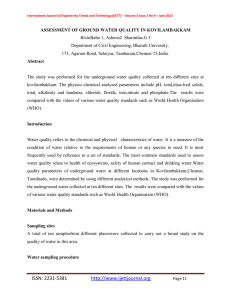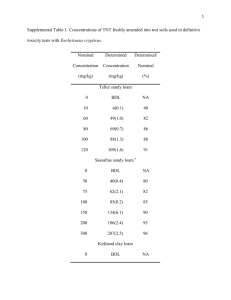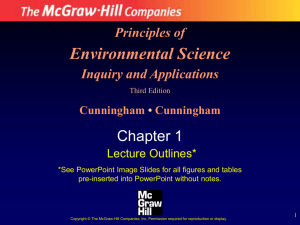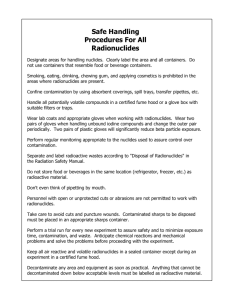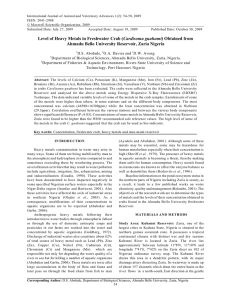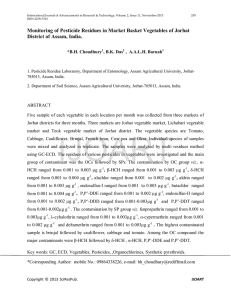Research Journal of Applied Sciences, Engineering and Technology 7(14): 2905-2907,... ISSN: 2040-7459; e-ISSN: 2040-7467
advertisement
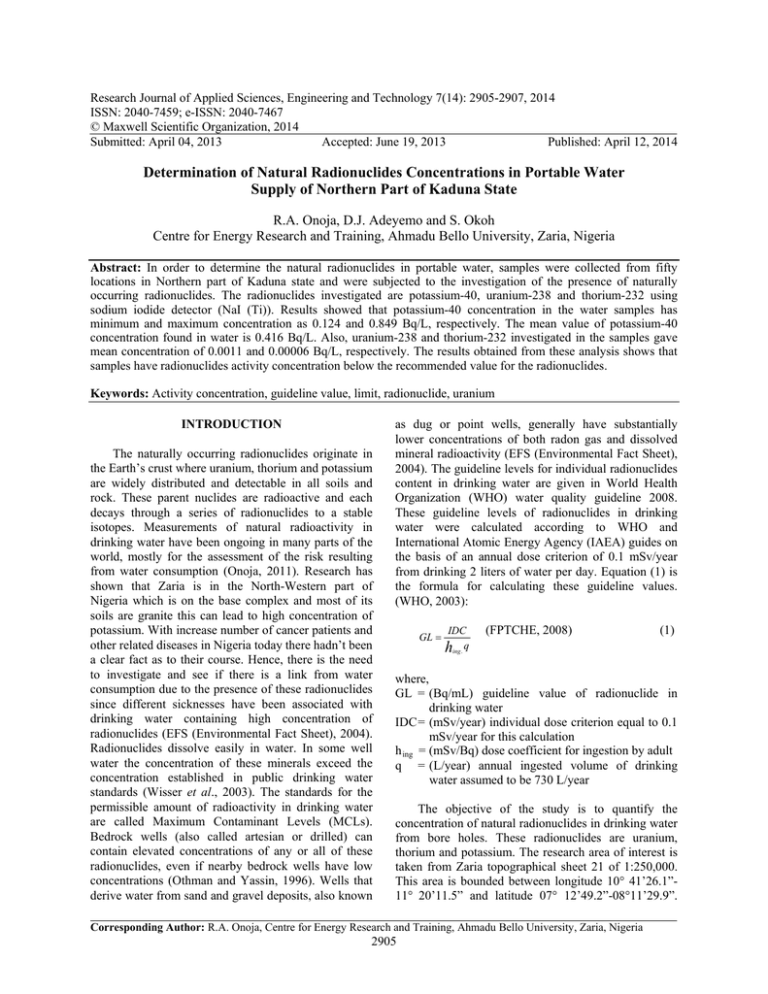
Research Journal of Applied Sciences, Engineering and Technology 7(14): 2905-2907, 2014 ISSN: 2040-7459; e-ISSN: 2040-7467 © Maxwell Scientific Organization, 2014 Submitted: April 04, 2013 Accepted: June 19, 2013 Published: April 12, 2014 Determination of Natural Radionuclides Concentrations in Portable Water Supply of Northern Part of Kaduna State R.A. Onoja, D.J. Adeyemo and S. Okoh Centre for Energy Research and Training, Ahmadu Bello University, Zaria, Nigeria Abstract: In order to determine the natural radionuclides in portable water, samples were collected from fifty locations in Northern part of Kaduna state and were subjected to the investigation of the presence of naturally occurring radionuclides. The radionuclides investigated are potassium-40, uranium-238 and thorium-232 using sodium iodide detector (NaI (Ti)). Results showed that potassium-40 concentration in the water samples has minimum and maximum concentration as 0.124 and 0.849 Bq/L, respectively. The mean value of potassium-40 concentration found in water is 0.416 Bq/L. Also, uranium-238 and thorium-232 investigated in the samples gave mean concentration of 0.0011 and 0.00006 Bq/L, respectively. The results obtained from these analysis shows that samples have radionuclides activity concentration below the recommended value for the radionuclides. Keywords: Activity concentration, guideline value, limit, radionuclide, uranium INTRODUCTION The naturally occurring radionuclides originate in the Earth’s crust where uranium, thorium and potassium are widely distributed and detectable in all soils and rock. These parent nuclides are radioactive and each decays through a series of radionuclides to a stable isotopes. Measurements of natural radioactivity in drinking water have been ongoing in many parts of the world, mostly for the assessment of the risk resulting from water consumption (Onoja, 2011). Research has shown that Zaria is in the North-Western part of Nigeria which is on the base complex and most of its soils are granite this can lead to high concentration of potassium. With increase number of cancer patients and other related diseases in Nigeria today there hadn’t been a clear fact as to their course. Hence, there is the need to investigate and see if there is a link from water consumption due to the presence of these radionuclides since different sicknesses have been associated with drinking water containing high concentration of radionuclides (EFS (Environmental Fact Sheet), 2004). Radionuclides dissolve easily in water. In some well water the concentration of these minerals exceed the concentration established in public drinking water standards (Wisser et al., 2003). The standards for the permissible amount of radioactivity in drinking water are called Maximum Contaminant Levels (MCLs). Bedrock wells (also called artesian or drilled) can contain elevated concentrations of any or all of these radionuclides, even if nearby bedrock wells have low concentrations (Othman and Yassin, 1996). Wells that derive water from sand and gravel deposits, also known as dug or point wells, generally have substantially lower concentrations of both radon gas and dissolved mineral radioactivity (EFS (Environmental Fact Sheet), 2004). The guideline levels for individual radionuclides content in drinking water are given in World Health Organization (WHO) water quality guideline 2008. These guideline levels of radionuclides in drinking water were calculated according to WHO and International Atomic Energy Agency (IAEA) guides on the basis of an annual dose criterion of 0.1 mSv/year from drinking 2 liters of water per day. Equation (1) is the formula for calculating these guideline values. (WHO, 2003): GL = IDC hing. q (FPTCHE, 2008) (1) where, GL = (Bq/mL) guideline value of radionuclide in drinking water IDC = (mSv/year) individual dose criterion equal to 0.1 mSv/year for this calculation h ing = (mSv/Bq) dose coefficient for ingestion by adult q = (L/year) annual ingested volume of drinking water assumed to be 730 L/year The objective of the study is to quantify the concentration of natural radionuclides in drinking water from bore holes. These radionuclides are uranium, thorium and potassium. The research area of interest is taken from Zaria topographical sheet 21 of 1:250,000. This area is bounded between longitude 10° 41’26.1”11° 20’11.5” and latitude 07° 12’49.2”-08°11’29.9”. Corresponding Author: R.A. Onoja, Centre for Energy Research and Training, Ahmadu Bello University, Zaria, Nigeria 2905 Res. J. App. Sci. Eng. Technol., 7(14): 2905-2907, 2014 Investigation of total alpha and beta particles has been carried out in these areas along with measurement of some physical parameters. MATERIALS AND METHODS A total of 50 water samples from bore hole were collected within Northern Kaduna in Nigeria 200 mL each of the samples was transferred into a 6.5 cm height plastic container. The samples in the containers were air tight and kept for one month to attain equilibrium. The natural radionuclides activity concentration of the samples was obtained using relative method. Also standard of natural origin were prepared in the same manner as the samples, these standards are uranyl nitrate (UO 3 (NO 3 ) 2 6H 2 O) 502.18 mol/g, potassium chloride (Kcl) 74.55 mol/g and thorium nitrate (Th (NO 3 ) 4 .5H 2 O) 570.13 mol/g. One gram of each of the standard was taken and dissolved into a 200 mL distilled water to form a standard solution. It is subtle that 1 g of uranyl nitrate contains 0.474 g of uranium which has activity of 0.0294 Bq/L, also 1 g of potassium chloride contains 0.534 g of potassium which has activity of 0.706 Bq/L and 1g of thorium nitrate contains 0.859 g of thorium with activity of 0.0175 Bq/L. The standard solution was kept to equilibrate before counting using NaI (Ti) detector with dimension 7.62×7.62 cm. The detector is connected to an Ortec unit consisting of amplifier, high voltage power supply and a NIMBIM and a computer system coupled with maestro software for data acquisition and analysis of gamma spectra in samples. The peak energy of 1764 KeV gamma-line of Bi-214 is used to estimate the activity concentration of uranium in samples. Also, the energy of 2614.5 KeV gamma-line of Tl-208 is used to estimate the activity concentration of thorium in the samples. The single energy of 1460 Kev gamma-line of potassium-40 gives the direct activity concentration measurement of potassium-40. The operational high voltage was set at 900v, Preset time 29,000 sec., ADC setup at 1024 and Micro ace amplifier gain 15.002. The detector was calibrated with cesium-137 and cobalt-60 sources and the energy resolution is 39.5 and 22.2%, respectively. The configuration and geometry was maintained throughout the analysis. The individual radionuclide concentration calculated using relative method as in Eq. (2): activity of U1 ∑ U1 − ∑ b = activity of S1 ∑ S1 − ∑ b (Onoja, 2011) (2) where, U1 = The unknown sample activity concentration in the unit of Bq/L S1 = Activity of the standard source ∑U1 = Sum under the peak of U1 in cps ∑S1 = The sum under the peak S1 in cps Table 1: Showing concentration of radionuclides in samples collected within Zaria Concentration of radionuclide (Bq/L) ------------------------------------------------Uranium Thorioum Potassium S/ID Sample location -238 -232 -40 R01 Kaya 0.000945 BDL 0.2751 R02 Gangara 0.002723 BDL 0.2746 R03 Yelwa BDL 0.000018 0.1713 R04 Danmahawayi 0.001922 0.000005 0.1575 R05 Hunkuyi 0.001195 0.000064 0.5895 R06 Gwibi 0.001053 0.000025 0.3038 R07 Idasu 0.000265 0.000360 0.3543 R08 Anguwan Mataha Madaki 0.000499 0.000001 0.4975 R09 Anguwan Danyaya 0.001237 BDL 0.5266 R10 Kudan 0.002385 BDL 0.2452 R11 Samaru 0.000836 0.000044 0.4127 R12 Likoro 0.000357 0.000007 0.3799 R13 Kuzai 0.001426 BDL 0.2856 R14 Recifa 0.000703 0.000011 0.3590 R15 F.G.G.C. Zaria 0.001260 0.000035 0.6179 R16 Patika 0.002266 0.000043 0.2715 R17 Bomo 0.000496 BDL 0.4039 R18 Kakangi 0.001579 BDL 0.2803 R19 Karau-Karau 0.001006 0.000021 0.4972 R20 Kanawa BDL 0.000019 0.3275 R21 Hanwa BDL 0.000027 0.3815 R22 Bagaldi BDL BDL 0.5809 R23 Tukun 0.000733 BDL 0.3482 R24 Turawa 0.000496 BDL 0.5022 R25 Turanwan Giwa BDL 0.000038 0.2759 R26 Giwa town BDL BDL 0.4879 R27 Zabi 0.000011 0.000241 0.7146 R28 Wazata BDL BDL 0.5657 R29 Hayin Liman BDL BDL 0.1948 R30 Kofar Gayan (Zaria city) 0.001406 0.000055 0.3880 R31 Aba 0.000659 0.000101 0.5745 R32 Yakasai 0.001735 BDL 0.4337 R33 Maigana BDL 0.000054 0.1237 R34 Soba BDL 0.000070 0.6356 R35 Shika 0.000893 BDL 0.3212 R36 Marmara 0.000081 0.000016 0.6265 R37 Kinkiba 0.001138 BDL 0.5389 R38 Yakawada 0.001165 BDL 0.4775 R39 Sharifai BDL 0.000016 0.2387 R40 Danwata 0.002431 0.000005 0.7077 R41 Chikagi 0.000508 BDL 0.1394 R42 Danjaba 0.002682 0.000023 0.5854 R43 Garun Gwanki 0.001012 BDL 0.6115 R44 Dogarawa 0.001290 0.000065 0.3846 R45 Gamagira BDL 0.000251 0.8489 R46 Gurbabiya 0.000662 0.000029 0.5108 R47 Gwanda BDL BDL 0.4274 R48 Hayimallam 0.001148 BDL 0.4114 R49 Unguwan Dafulani 0.000224 BDL 0.2816 R50 Zango 0.000981 0.000030 0.2723 RESULTS AND DISCUSSION Table 1 shows the results of activity concentration of natural radionuclides in potable water from borehole water supply system. These radionulides are uranium238, thorium-232 and potassium-40. The average activity concentration of uranium, thorium and potassium was found to be 0.000833, 0.00005039 and 0.4191 Bq/L, respectively. The minimum and maximum values for these radionuclides were 0.003 and 0.000011 Bq/L for Uranium-238, 0.00038 and 0.000001 Bq/L for Thorium-232 and 0.419 and 0.124 Bq/L for potassium-40, respectively. Results show that out of the 50 sample analyzed, 100% of the sample has traceable amount of potassium-40 activity concentrations in the samples, 44% of the sample has thorium-232 activity concentration while 26% of the 2906 Uranium radioactivity concentration ( Bq/L) Res. J. App. Sci. Eng. Technol., 7(14): 2905-2907, 2014 0.00003 0.000025 0.00002 0.000015 0.00001 0.000005 0 Sampling locations Fig. 1: Is an area plot uranium-238 concentrations against sampling locations Th-232 radioactivity concentration (Bq/L) 0.000004 0.000003 0.000003 0.000002 0.000002 above 100 mBq/L have been observed in areas with uraniferous granitic intrusions. The new drinking water regulation being proposed by the Environmental Protection Agency does not include a listing for K-40 but specifies that the maximum allowable Concentrations limit for beta and photon emitters should correspond to a committed effective dose equivalent of 4 mrem/a from annual intake at the rate of two litters of drinking water per day. Figure 1 to 3 is plot of the activity concentration against sampling locations. Examination of these figures shows that the potassium activity concentrations are widely spread and the concentration is densely distributed in the sampling location. Followed in the same pattern of distribution, is the distribution of the uranium concentration. Thorium232 with least concentrations has the least spread distribution in these locations. This agrees with the fact that generally thorium concentration in water is in a very low concentration level. 0.000001 CONCLUSION 0.000001 0.000000 0 Sampling locations K-40 radioactivity concentration (Bq/L) undreds Fig. 2: Is an area plot thorium-232 concentrations against sampling locations 0.009 The high concentration observed in the spread of potassium-40 in the water samples could be due to the enhancement of natural potassium on land as a result of mans’ activities such as fertilizer and manure application on farm land, as well as drop-out from animals. These during raining season are washed into water bodies or leached into the soil. Samples which activity concentrations are not detected are reported as Below Detection Limit (BDL). 0.008 0.007 REFERENCES 0.006 0.005 0.004 0.003 0.002 0.001 0 Sampling locations Fig. 3: Is an area plot potassium-40 concentrations against sampling locations sample has uranium-238 concentration. However 40% of the total sample contains these three radionuclides in appreciable level of concentrations. From this study it was observed that the radionuclide activity concentrations discovered were below the standard set by the Environmental Protection Agency. The range of thorium in natural water is set at 1.0-10 mBq/L whish is extremely low, uranium set range is 10-100 mBq/L although higher concentration EFS (Environmental Fact Sheet), 2004. Environmental Services WD-WSEB-3-11. New Hampshire, pp: 7. FPTCHE, 2008. Guideline for Canadian drinking water quality summary table. Federal-ProvincialTerritorial-Committee on Drinking Water of the Federal Provincial Territorial Committee on Health and Environment (FPTCHE). Retrieved form: http://www. he-se.ge.ca/ewh-semt/alt formats/heessese/ pdf/pubs/ water-eau/ sumguide-resrecom/ summary-sommaire-eng.pdf. Onoja, R.A., 2011. Determination of natural radioactivity and committed effective dose calculation in borehole water supply, Zaria. Ph.D. Thesis, Ahmadu Bello University Zaria (Unpubl). Othman, A. and C. Yassin, 1996. Natural radioactivity of drinking water in the southern and middle part of Syria. Environ. Int., 22: 355-359. WHO, 2003. Guideline for Drinking Water Quality WHO. Vol. 3, Ch. 9, Geneva, Switzerland. Wisser, S., D. Fischer, P. Jansch and B. Kieser, 2003. Natural Radioactivity in Drinking Water Supply. Nordic, Europe, pp: 5. 2907

